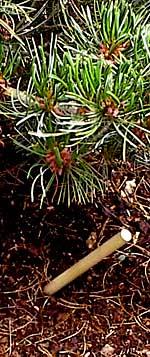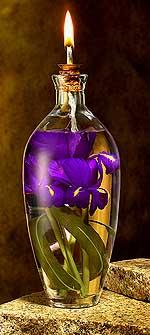
Watering & Irrigation tips: newly installed plants, shrubs and trees
Text Copyright 2002 - 2020 by Mario D. Vaden
The suggestions below are based on experience in western Oregon, but are applicable for much of the northwest and other parts of the USA.
Watering & Irrigation
Whether 19" to 75" of natural rainfull per year, plants benefit from mulching and proper irrigation. This is because each area can experience consecutive weeks without rain. If shrubs and trees are established, then proper irrigation may be no extra water.

advertisement
Also, don't believe the myth that native plants are drought tolerant. The truth is that drought-tolerant plants are drought tolerant. Some of our native plants need plenty of sprinkling or moisture, and would grow naturally in shaded or moist areas.

With newly planted woody shrubs and conifers, it's easy to remove mulch to check moisture of the soil. But some people don't have skill or experience to estimate moisture content inside a rootball, which the most important soil to keep moist and watered.
To the right is a photo of a dowel rod inserted in a root ball to monitor soil moisture. That homemade tool provided success for people who did their own irrigating. Its my preferred method too. Saw 1/4" to 1/2" diameter wood dowels into 12" to 14" lengths, sharpen an end, and insert one, or more into a root ball.
The sticks are left in place and pulled out every day or two to see if the wood surface is moist or dry, indicating the presence or absence of moisture. This method can be more practical than fliddling with moisture meters. Moisture meters can work too, but consider the dowel method for an alternative. The dowel method is inexpensive and reliable. As long as the stick fits tight, use the same holes each time. This limits probing in the root zone.
One extra benefit of dowels is lack of malfunction. What if your moisture meter malfuntions? How would you know if its defective? That's the best part about dowels. That stick will be moist or dry.
A newly planted rootball is comparable to the wick of an oil lamp and it's oil reservoir. Pretend that the leaves are the flame, the stem and roots are the wick, the rootball is the reservoir, and the water is like the oil. Just as an oil lamp wick does not receive oil from any other source than the reservoir, a newly planted canopy of leaves can't draw water from anywhere except within the rootball. That's where its roots are at to begin with.

The surrounding soil could be moist, but it the rootball dries out, the plant can die. The root ball is the most critical area of soil to keep moist. Eventually the roots will grow and extend into the fill soil, but that may take weeks or months. This does not mean its unimportant to keep the fill soil moist too. That is important also, because the fill soil is where new root growth will extend.
The idea for irrigating is to keep roots wet or moist, not drenched or water-logged. Remember that a lot of the native soil in Oregon, is slower draining than the planting soil or potting soil of nursery plants. Don't water until the plant is sitting in liquid. In fact, you may benefit from backfilling the planting hole with the soil which was dug from it.
The problem for many people is not so much figuring out how frequently to water but that they don't monitor the amount of moisture in the soil.
Barkdust will make or break success in most cases. Maintain a consistent 1" to 3" deep layer over the planting area and rootball. That will help retain moisture - read our advice topic on mulch and barkdust.
If you plant in autumn, don't forget to check the moisture of the rootball in late fall or winter if there are extended periods without rain. Sometimes a quick light drizzle of rain that barely penetrates the soil surface will be insuffient autumn irrigation.
In the spring or summer, you may need to water plant root balls almost every second to third day when weather is 60 degrees to 70 degrees. If the weather is 70 to 85 degrees, watering may be needed every day or two. If the weather is 85 to 100 degrees, waterering could be needed daily. In the high 90s, irrigation could be required twice per day if the tree has a large canopy of foliage and disproportionately small rootball.
On the other hand, it could be 90 degrees and watering needed only every 2nd or 3rd day. No guideline of formula supercedes monitoring the moisture in the rootball. That's why I emphazised the problem earlier, that some people don't keep track of rootball moisture.
We don't need to flood the plants. Suppose it's a 100 degree day, and we have a 6' tall arborvitae, typically with a large amount of foliage with a small rootball. We could water it twice during the 100 degree day: 1 gallon in the morning and another 1 gallon at night. Two light waterings instead of one heavy one.
How will we know if that was too much or two little water? Simple, by monitoring the moisture. That's why formulas are hard to make, and probably not good to follow. The only smart formula is to monitor moisture in the soil on a regular basis. In a week or two, most people will begin to figure out how fast their soil dries out.
Some factors will change watering suggestions. One is wind, the other is the size of the canopy. Humidity can reduce the irrigation requirement.
Even given these suggestions, we should still be monitoring the moisture in the soil on days that you are not watering.
It's better to check moisture in the rootball and fill soil, than to guess about water while waiting to see wilting leaves. Some people believe that it's better to look at foliage for signs of drying - then water. I don't recommend that.
Letting roots get too dry is not good. Any living plant needs moisture. There is a point where the moisture drops so low that the plant can't recover. This is called the permanent wilting point. Since plants always need a little moisture, the rootball needs to be moist at all times. So where is the danger point? You don't want to find out! Keep the rootball moist, but not saturated.
Sometimes I spray manually into the canopy of shrubs, hardwoods, and softwoods, letting water drip down. And I'm a firm believer in using occassional hand watering even if there is an irrigation system. If you rely 100% on automatic irrigation to do the job, odds are that you will be over watering some plants too much.
One of my favorite watering tools is a long wand with a shower head at the end. Providing a long reach into flower beds where I can't step, or over tall hedge plants.
For trees, it's been said, that it may be better to water every few days or week, if established, at a slow irrigation rate for long intervals. My view is that irrigation rates should be reduced for many established trees so the roots grow a bit deeper. If the species are small like Japanese maple or vine maple, maybe irrigate more often. But with large conifers like Douglas fir or western hemlock, why not eventually drop the moisture to near the lowest levels that could occur naturally? Ever noticed how many conifers grow naturally in Oregon, through relatively dry summers? Nature can provide some examples for us too.
Now more about established plants. Professional research indicates that newly planted hardwoods and softwoods can establish better if watered frequently to keep the rootball and roots moist. Not water-logged of course. For the first growing season or two. After that, less irrigation may be needed. It depends on where you live.
I read an article once that may have been a bit misleading. It said that roots do not grow DOWN TO water, but grow WHERE water is. From a technical point of view, that may be accurate, but to the common understanding of an average person, that may be more confusing. Yes, roots do grow where there is moisture. But as the moist area progressively "moves" downward with seasonal drying, so will the roots, which have been growing in it and following it along. So figuratively and practically speaking, it is safe to say that roots grow toward water. And the lower that roots can grow, the better the plants will be anchored. That's why it's good to keep plants moist, but not flooded.
Years ago, I read a book showing how someone caused plant roots to extend by "training" the root system. A small obelisk rock with a flat-cut base was set in a very shallow tray pot, like a Bonsai pot. A plastic wrap was used to hold soil around the stone up to its top. A small Chrysanthymum was planted on the very top. As the plant grew, the plastic was peeled down and soil removed and washed away. The plant's roots elongated more and more and more, extending exposed and down across the face of the rock. Eventually, the finished project was a plant on top, with bare smooth roots grasping the rock, extending into a couple of inches of soil in the bottom of tray to get moisture and nutrients. This is why I indicated that in general terms, roots can grow to water.
If you have planted something like arborvitae in summer that have enormous canopies compared to the root ball size, inquire at a local nursery for an antidessicant spray. That kind of spray seals the foliage to retain moisture. It's a secondary measure. It's best to prolong planting of plants like that until weather is cooler, but in case the planting occured anyway, that spray is very effective on plants that have disproportion between the canopy foliage and root system. Generally, I suggest that people wait to plant Thuja hedge plants between late September and April.
If you are ready to choose an irrigation system, your options include drip irrigation with it's accessories like emmiters, micro spray heads and perforated tubing. Personally, I find drip systems to be a nuisance. The emmiters are hard to see to determine if they are working. The moisture that they emit is hard to keep track of. And the tubes get in the way of gardening tasks like planting and weeding and mulching. For these reasons, I prefer sprinklers with a properly designed irrigation system.
The drip irrigating may be required for exceptionally large yards with wells, or in arid climates where residents try to salvage every last teaspoon of water. And sometimes local codes may require drip irrigation.
If sprinklers are used and can run between 9 pm and 10 am in the morning, they can be nearly as water efficient as a drip system. Sprinklers can apply a more consistent coverage in many cases, because drip emitter water moves downward and outward in an inverted cone shape. Sprinkler water is an entire layer that moves downward: closer to how natural rain irrigates a layer of moisture.
Good soil preparation and mulching allow better water infiltration from irrigation. When soil is porous and not compacted, water can be applied quicker. This means that each irrigation zone will operate for less time. More irrigation zones can operate in the limited number of hours from 11pm to 8am (my preferred hours for irrigating).
Sometimes, h omeowners and landscape contractors use drip emitters around trees that are planted. What happens when the trees increase their size and mass by 100 times in the next 20 years? Add more emitters? Likewise, it's not wise to design a sprinkler irrigation system with no room for an extra sprinklers on each zone.

advertisement